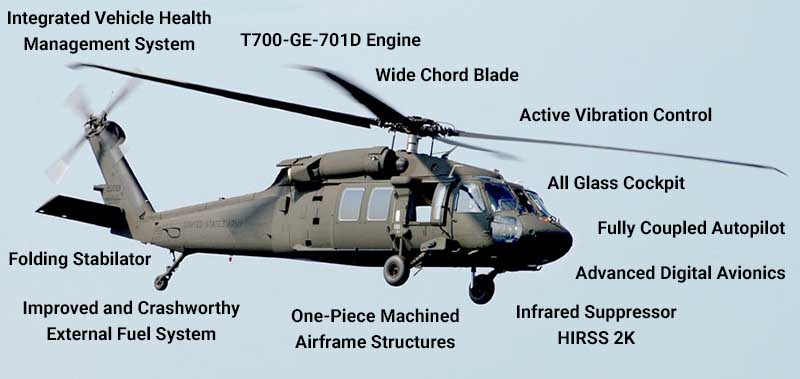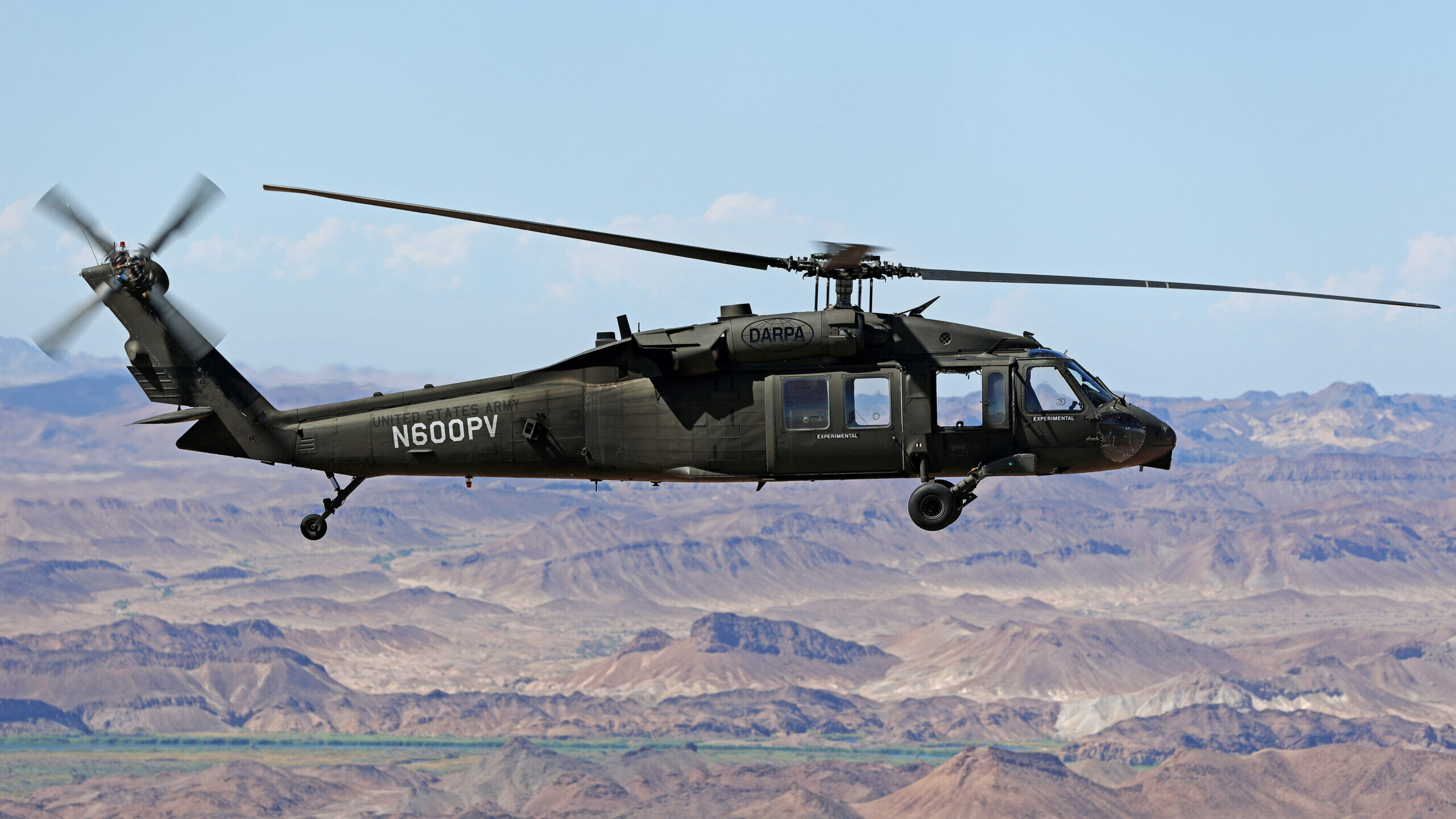UH-60: Technologies in Modern Helicopter Layout
The UH-60 helicopter stands as a standard in contemporary air travel, showcasing significant advancements in layout and innovation that accommodate the evolving needs of armed forces operations. Its incorporation of innovative products not only enhances efficiency but additionally addresses critical safety and security worries. Additionally, the assimilation of sophisticated avionics has transformed operational capabilities, permitting higher situational awareness and decision-making performance. As we check out the advancement and crucial developments of the UH-60, it comes to be vital to consider exactly how these developments influence not just current applications yet also the future landscape of helicopter style.

Development of the UH-60
The development of the UH-60 Black Hawk helicopter represents a significant milestone in aerospace design and army air travel. Introduced in the late 1970s, the UH-60 was developed by Sikorsky Aircraft to meet the USA Army's need for a functional energy helicopter efficient in carrying out a range of objectives. Its style highlighted maneuverability, longevity, and rate, establishing brand-new requirements for operational efficiency.
The UH-60 features a distinct four-blade blades system, which improves lift and stability, permitting it to operate properly in diverse settings. Its airframe is constructed from innovative composite materials, adding to a reduction in weight while preserving architectural stability. The helicopter's layout likewise includes improved the rules of aerodynamics, which boosts fuel performance and boosts array.
Throughout the years, the Black Hawk has gone through numerous upgrades to improve its capacities, including enhanced engines, progressed trip control systems, and modular systems for easy maintenance and flexibility. The helicopter's capacity to execute goals ranging from troop transport to medical emptying has solidified its function as a foundation of united state army procedures. The UH-60 Black Hawk remains an archetype of exactly how advancement in helicopter layout can considerably affect armed forces performance and functional adaptability.
Advanced Avionics Equipments
Advancements in avionics systems have transformed the capabilities of contemporary helicopters like the UH-60 Black Hawk, improving operational efficiency and situational understanding (UH 60). The combination of advanced avionics permits enhanced navigating, communication, and flight administration, making the UH-60 a lot more flexible in diverse mission accounts
Among the crucial functions is the sophisticated digital cabin, which uses multifunction screens that supply real-time data, guaranteeing pilots have immediate access to critical trip details. This streamlining of info reduces pilot workload and boosts decision-making procedures during facility procedures. Furthermore, the incorporation of general practitioner and inertial navigating systems enables precise positioning and route preparation, enhancing objective execution in tough settings.
Additionally, advanced avionics systems enhance interaction abilities with protected data links and voice interaction systems, enabling seamless coordination with ground pressures and various other airplane. The combination of automatic flight control systems better adds to enhanced stability and control, particularly in adverse weather or throughout low-altitude maneuvers.
Engine and Efficiency Enhancements
Engine performance in modern-day helicopters has taken a considerable leap onward, driven by advancements that boost reliability, performance, and power. At the leading edge of these developments is the fostering of even more effective turboshaft engines, especially those using advanced products and technologies that allow greater temperature resistances and increased thrust abilities. The UH-60 Black Hawk, for circumstances, makes use of the T700-GE-701C engine, which includes a dual-channel, full-authority digital engine control system. This system enhances performance while enhancing gas intake and decreasing upkeep demands.
Furthermore, the integration of engine health tracking systems permits real-time diagnostics and predictive maintenance, considerably enhancing operational reliability. These systems not only alert staffs to possible concerns prior to they end up being essential view it yet additionally assist in much more effective maintenance organizing, consequently minimizing downtime.

Materials and Structural Innovations
Recent developments in materials and structural style have reinvented modern-day helicopter construction, enhancing both performance and toughness. The intro of sophisticated composite products, such as carbon fiber enhanced polymers, has actually dramatically lowered weight while keeping architectural honesty. This change not just boosts gas performance however likewise boosts payload capability, allowing helicopters like the UH-60 to carry out more diverse goals.
Furthermore, advancements in aluminum alloys and titanium components have actually added to improved resistance to corrosion and exhaustion, expanding the life expectancy of crucial airframe elements. The critical use these materials has actually caused a reduction in upkeep demands and improved total functional readiness.

Furthermore, the assimilation of computer-aided style (CAD) and additive manufacturing modern technologies has made it possible for much more light-weight structures and complicated geometries, optimizing the wind resistant performance Continued of helicopter layouts. These developments facilitate quick prototyping and production, permitting makers to respond swiftly to advancing objective demands.
Safety and Survivability Functions
Safety and security and survivability features in contemporary helicopter layout have ended up being critical, showing the increasing demands for objective performance in difficult settings. The UH-60 Black Hawk, a noteworthy instance, integrates sophisticated technologies to improve staff and passenger defense. One of the most critical developments is the consolidation of crashworthy gas systems created to minimize the threat of fire during effect. Additionally, the airframe is created with strengthened products that dissipate and absorb energy, additional protecting occupants in case of an accident.
The helicopter likewise utilizes a ballistic protection system, which includes armored team seats and important systems shielding, reducing susceptability to tiny arms fire and shrapnel. Improved situational understanding is achieved via innovative avionics and sensor technologies, permitting pilots to identify and stay clear of dangers efficiently.
Moreover, the assimilation of redundancy in important systems-- such as double engines and multiple trip control channels-- ensures ongoing operation also if one system stops working. The UH-60 is geared up with innovative emergency situation flotation tools, improving survivability in water touchdowns. Collectively, these features not just improve the safety and security of workers yet also raise goal success rates in aggressive atmospheres, demonstrating the commitment to quality in helicopter design.
Final Thought
The UH-60 helicopter represents a substantial development in modern-day air travel modern technology, integrating cutting-edge materials, sophisticated avionics, and robust security features. Its development mirrors a commitment to improving efficiency and operational effectiveness while ensuring pilot and team survivability. The assimilation of lightweight composites and progressed navigation systems underscores the helicopter's flexibility in various military objectives. Overall, the UH-60 works as a criteria for future growths in helicopter design, symbolizing strength and versatility in contemporary armed forces procedures.
The UH-60 helicopter stands as a criteria in modern-day aeronautics, showcasing substantial advancements in design and innovation that provide to the progressing needs of army operations. As we check out the advancement and essential advancements of the UH-60, it comes to be crucial to web consider how these growths affect not just existing applications however likewise the future landscape of helicopter style.
Presented in the late 1970s, the UH-60 was made by Sikorsky Airplane to satisfy the United States Military's demand for a functional energy helicopter qualified of performing a selection of goals. The UH-60 Black Hawk continues to be a prime instance of exactly how development in helicopter design can considerably impact army performance and functional versatility.
Overall, the UH-60 offers as a criteria for future advancements in helicopter design, personifying durability and adaptability in contemporary military procedures.
Comments on “The Development of the UH 60: From Its Beginning to Modern-Day Enhancements”